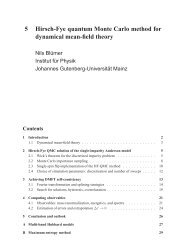Hubbard Model for Asymmetric Ultracold Fermionic ... - KOMET 337
Hubbard Model for Asymmetric Ultracold Fermionic ... - KOMET 337
Hubbard Model for Asymmetric Ultracold Fermionic ... - KOMET 337
Create successful ePaper yourself
Turn your PDF publications into a flip-book with our unique Google optimized e-Paper software.
2 CHAPTER 1. INTRODUCTIONlattice site x i , we can expand the potential around its minimum in x = x i :V (x) ∼ − V 0d( [d − π2(x -2a 2(x - x i) 2 xi ) 4 )]+ Oa 4(1.4)∼ π2 V 02da 2 (x − x i) 2 − V 0 .With this approximation we can represent Wannier-states, localized at lattice site i, by agaussian times a Hermite polynomial, which are the well-known solutions of the harmonicoscillator problem. Since we are interested only in low temperature physics, we consider onlythe ground state of this harmonic oscillator and identify it with the Wannier-state localizedat the lattice site i. There<strong>for</strong>e we neglect all energetically excited states. The ground state isgiven as:ψ(x) = 1l d 2)exp(− x22l 2, l =Here we present the approximation graphically:V(x), V app (x), |ψ(x)| 2 (a.u.)4√mω , ω = π √V0a md. (1.5)321-4 -2 2 4x-1Figure 1.1: Plot of periodic potential V (x) in its cosine <strong>for</strong>m and its parabolically approximated<strong>for</strong>m. The probability density |ψ(x)| 2 is very small in the region where the approximationbreaks down.Hence, the harmonic oscillator approximation is good, since the probability density |ψ(x)| 2decreases rapidly with growing values of |x − x i |, so the atoms “feel” only the approximatepotential (1.4). With this tight-binding approximation we can derive a one-band <strong>Hubbard</strong>modelas follows.Since the Wannier-functions located at different sites overlap, the atoms may tunnel fromone site to the other. In this thesis we consider only tunneling processes from one site to itsnearest neighbors and neglect all other tunneling processes. The tunneling process, whichis called “hopping” in the <strong>Hubbard</strong> model language, gives the following contribution to thecontribution to the Hamiltonian (see <strong>for</strong> example [24] [25]):H t = − ∑ (ij)σt σc † iσ c jσ, (1.6)where c † jσ and c iσdenote the creation/annihilation operators of the Wannier-states locatedat the lattice sites i/j and σ denotes the pseudo-spin, used to describe the fermion’s internal













